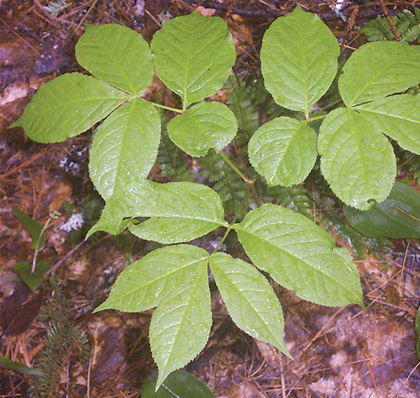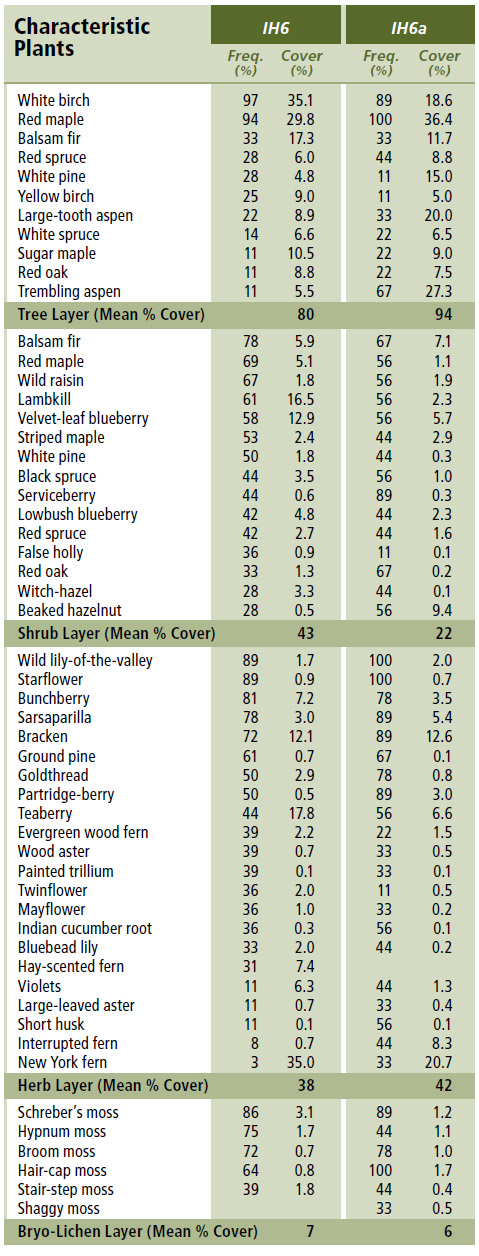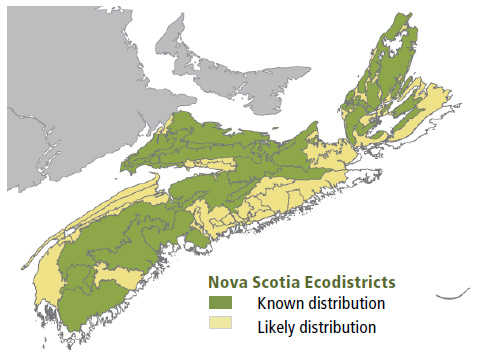
Forest Vegetation types - IH6
IH6 — White birch – Red maple / Sarsaparilla – Bracken
Betula papyrifera – Acer rubrum /Aralia nudicaulis – Pteridium aquilinum
IH6a — Aspen variant
Populus grandidentata – Populus tremuloides
 |
Black Lake, Cumberland County |
Concept: This early successional Vegetation Type (VT) has an overstory co-dominated by white birch and red maple, with minor associates. The IH6a variant describes stands where aspen (trembling and/or large-tooth) co-dominates with the birch and maple. Together with its variant, IH6 can grow in a wide range of ecological conditions —from dry to moist and poor to rich sites. White birch – Red maple / Sarsaparilla – Bracken usually follows stand-replacing disturbances events such as fire, windthrow or clearcutting.
Vegetation:White birch and red maple are the dominant overstory trees, while aspen species are co-dominant in variant IH6a. Balsam fir, red spruce, white pine, yellow birch and/or white spruce are common canopy associates. The shrub layer is often well developed and includes several regenerating tree species, wild raisin, lambkill, velvet-leaf blueberry, striped maple and serviceberry. A variety of plants can be found in the herb layer, reflecting the range of site conditions supporting this VT. However, the majority of plants are associated with relatively poor fertility and fresh to dry soils. Common herbaceous species include starflower, bunchberry, sarsaparilla, bracken and ground pine. The bryophyte layer is usually poorly developed, but often contains patches of Schreber's moss, hypnum moss on decaying wood, and hair-cap moss on recently disturbed soil.
Environmental Setting: IH6 is associated with a range of site conditions ranging from relatively dry, poor, coarse textured soils to relatively moist, rich, fine textured soils (and combinations in between). This VT is common and widespread throughout the province. This is the most common white birch VT in the Acadian Forest, ranging widely across New Brunswick and Prince Edward Island.
Successional Dynamics:IH6 is an early successional VT that follows stand-level disturbances in both softwood and hardwood forests. Typical disturbance agents include fire, windthrow and harvesting. With time, short-lived white birch and aspen will deteriorate due to natural senescence, insects and disease and/or wind damage – leading to a range of possible successional VTs. The presence of other canopy and understory species, particularly residual trees from pre-disturbance conditions, should be used to assess likely successional trends.
Ecological Features: This early successional deciduous forest typically occurs as large patches following stand level disturbances such as fire or tree harvesting. Regeneration is by seed and coppice. White birch is shade-intolerant and is short-lived. The sudden exposure of white birch stems to increased sunlight and heat, which usually occurs after a partial stand disturbance, usually leads to birch mortality. Red maple has greater longevity and shade tolerance, both of which facilitate its persistence into later successional stages. It also flowers before most other spring plants, providing one of the most important early and abundant pollen and nectar sources used by a wide range of insects. Both species, but red maple in particular,are favoured as browse for deer and moose.
 |
| Sarsaparilla |
Distinguishing Features: The canopy of this hardwood forest is dominated by early successional species (red maple, white birch, trembling and large-tooth aspen). Wild raisin, blueberry, lambkill, bracken and sarsaparilla are usually present. Aspen is diagnostic for the variant IH6a.
| Slope Position: | Upper5 Middle3 Level1 Lower1 |
Surface Stoniness: |
(Non - Slightly)6 (Moderately)3 (Very - Excessively)1 |
Bedrock Outcrop: |
(Non-rocky)9 (Slightly - Moderately)1 |
Elevation Range: |
8 - 229m |
Slope Gradient: |
Gentle7 Moderate1 Level1 nd1 |
Aspect: |
North3 East1 South2 West3 None1 |
Exposure: |
Moderate8 Mod. exposed2 |
Microtopography: |
Moderately6 Slightly3 Strongly1 |
Drainage: |
Well6 Moderately well2 Imperfect2 |
Soil Type: |
ST24 ST2-L2 ST61 ST151 Other2 |
Parent Material: |
Glacial till9 Till/Bedrock1 |
Rooting Depth (cm): |
(<30)1 (30-45)3 (>45)4 nd2 |
Duff Thickness (cm): |
(0-5)3 (6-10)4 (11-20)1 nd2 |

